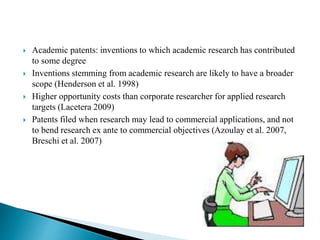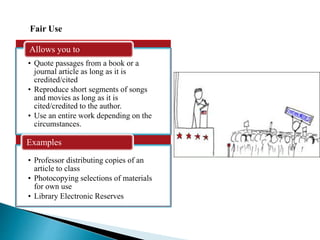Academia and Patents
- 1. Rajni Mishra
- 2. Academia and patents - Indian National S&T Policy 2003 - Technology Transfer & IPR - National schemes for promotion of tech transfer - Indian Bayh-Dole Act - Publication and anticipation Fair Dealing Indian Patent Agent Exam
- 4. Academic patents: inventions to which academic research has contributed to some degree Inventions stemming from academic research are likely to have a broader scope (Henderson et al. 1998) Higher opportunity costs than corporate researcher for applied research targets (Lacetera 2009) Patents filed when research may lead to commercial applications, and not to bend research ex ante to commercial objectives (Azoulay et al. 2007, Breschi et al. 2007)
- 5. Vigorously foster scientific research in universities and other academic, scientific and engineering institutions Provide necessary autonomy and freedom of functioning for all academic and R&D institutions so that an ambience for truly creative work is encouraged, while ensuring at the same time that the science and technology enterprise in the country is fully committed to its social responsibilities and commitments To establish an Intellectual Property Rights (IPR) regime which maximises the incentives for the generation and protection of intellectual property by all types of inventors. Provide a strong, supportive and comprehensive policy environment for speedy and effective domestic commercialisation of such inventions Encourage scientists and technologists to transfer the know-how generated by them to the industry and be a partner in receiving the financial returns Encourage Industry to financially adopt or support educational and research institutions, fund courses of interest to them, create professional chairs etc. to help direct S&T endeavours towards tangible industrial goals
- 6. Ministry of Science and Technology has issued the guidelines "Instructions for Technology Transfer and Intellectual Property Rights“ to help in enhancing the motivation of scientists, research institutions and universities in projects funded by the Department of Science and Technology, Department of Biotechnology, Department of Scientific and Industrial Research and Department of Ocean Development Ownership of Intellectual Property Transfer of technology Royalty to inventors Norms for private industry Patent facilitating fund Information March in rights
- 7. National IPR Facilitating Centers 1) National Research Development Council (NRDC) Partnering innovators, entrepreneurs, institutions to protect their innovations in India and abroad and also help to commercialise their IPR 2) Technology Information and Forecasting Cell (TIFAC) Facilitating patent searches, funding and facilitating filing of patents, partnering in commercialisation of IPR 3) National Innovation Fund Working with grass-root innovators to protect their innovations and also to facilitate technology transfer/ IPR commercialisation 4) Technology Incubation Programme DST Funded incubation centers set up to facilitate entrepreneurship development and IPR development and transfer
- 8. Academic-industry-government teamwork for targeted delivery of business oriented results through innovative funding schemes such as New Millennium Indian Technology Leadership Initiative (NMITLI) http://www.csir.res.in/nmitli/nmitli.html; Drugs & Pharmaceutical Research http://dst.gov.in/scprog/tecdev/drugspharmares.htm; Grants to Industry- Technological Self Reliance (PATSER) http://dsir.nic.in; Home- Grown Technology Programme (HGT) http://www.tifac.org.in/; Department of Information Technology http://www.mit.gov.in/R&D/projects/index.htm#about
- 9. The Protection and Utilisation of Public Funded Intellectual Property (PFIP) Bill, 2008 Autonomy to institutions to protect, own and commercialize IP Encourage creation of IP and promote culture of innovation The Bill requires the scientist who creates an intellectual property to immediately inform the research institution. The institution shall disclose this information to the government within 60 days. The institution is required to inform the government of the countries in which it proposes to retain the title to the PFIP. The title in all other countries will vest in the government. The scientist shall be paid a minimum of 30 per cent of net royalties received from the PFIP.
- 10. Patent before you publish Grace period – anticipation by publication and public use Section 31(d) – an invention shall not be deemed to have been anticipated by reason only of the description of the invention in a paper read by the true and first inventor before a learned society or published with his consent in the transactions of such a society.
- 12. Limitation and exception to the exclusive right granted by copyright law to the author of a creative work Doctrine of equity The laws relating to fair dealing have been incorporated in Section 52 of The Copyrights Act, 1957. Indian Copyright Act does not define the term "fair dealing” Hubbard v Vosper, Lord Denning- “It is impossible to define what is "fair dealing". It must be a question of degree. You must first consider the number and extent of the quotations and extracts.... then you must consider the use made of them....Next, you must consider the proportions...other considerations may come into mind also. But, after all is said and done, it is a matter of impression."
- 13. Certain acts not to be infringement of copyright. – fair dealing or private use and criticism, fair dealing for the purposes of reporting, reproduction in a judicial proceeding, reproduction or publication for Legislative purposes, permits reproduction for the purposes of a certified copy, permits only reading and recitation of a reasonable extract, permits publication in a collection of essentially non-copyright matter for use in “educational institutions” reproduction during the course of instruction or in examinations performance in the activities of an educational institution making sound recording of the work with the license or consent of the owner of the work performance in an amateur club to a non-paying audience, or in a religious institution making of three copies for a library if the book is not sold in India
- 14. • Quote passages from a book or a journal article as long as it is credited/cited • Reproduce short segments of songs and movies as long as it is cited/credited to the author. • Use an entire work depending on the circumstances. Allows you to • Professor distributing copies of an article to class • Photocopying selections of materials for own use • Library Electronic Reserves Examples Fair Use
- 15. Passage: “The interrelations among research, development, and innovation are neither linear, nor static. The past decade or so witnessed insightful rethinking of what is important.” - Alan L. Porter, Tech Mining” to Drive Open Innovation
- 16. Outright plagiarism. Jerry does not indicate that the words and ideas belong to Porter, and has stolen the words and ideas and tried to cover the attempt by tweaking few words. The relationship between research, development, and innovation are neither linear, nor static. The previous decade witnessed insightful rethinking of what is important. Original Passage: “The interrelations among research, development, and innovation are neither linear, nor static. The past decade or so witnessed insightful rethinking of what is important.” - Alan L. Porter, Tech Mining” to Drive Open Innovation
- 17. Though Garfield acknowledges his source, the paraphrasing amounts to plagiarism, because he has copied the original. Alan L. Porter states that the interrelations among research, development, and innovation are neither linear, nor static. The past decade or so witnessed insightful rethinking of what is important.
- 18. Donald has paraphrased the text appropriately. He identified his source at the beginning of the paragraph, letting readers know who is being quoted He provided a footnote directing them to the exact source of the statement. He paraphrased some of Porter’s words and quoted others, but makes it clear to the reader which words are his and which belong to Porter. Alan L. Porter propounds that “the interrelations among research, development, and innovation are neither linear, nor static.” According to him, recent past stands witness to the “insightful rethinking of what is important.”
- 19. A patent agent is an individual who is registered for practicing before an Indian Patent Office Patent agent Examination is held by the Indian Patent Office once each year. This examination is conducted at Mumbai, Delhi, Nagpur, Chennai and Kolkata.
- 20. Eligibility criteria: Applicants need to be an Indian citizen and is to complete 21 years of age at exam time. All technology and science graduates (M.Tech, B.Tech, M.Sc. and B.Sc,) from any established university under Indian law or other specified equivalent qualification under central government is eligible for appearing the exam. The final year candidates also are eligible on producing the mark sheets, final degree, etc., within two months from Patent Agent exam declaration result which they are appearing for. Patent Agent Exam Paper Pattern:- - The written examination consists of two papers of 100 marks each. •Paper 01: Patent Acts and Rules •Paper 02:Drafting and interpretation of the patent specification and other documents - Viva -voce http://www.ipindia.nic.in/
- 21. Got an idea? Get in touch! Rajnimishra7@gmail.com





















